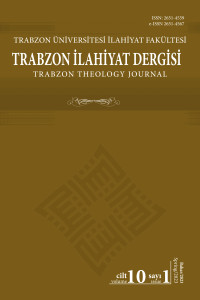Diyanet İşleri Başkanlığı Merkez Kütüphanesi’nde Kayıtlı Üç Memlük Mushafının Kitap Sanatları Açısından İncelenmesi
An Investigation of the Three Mamluks Mushafs Registered in the Central Library of the Directorate of Religious Affairs in Terms of Book Arts
Author(s): Abdurrahim AyğanSubject(s): Fine Arts / Performing Arts, Visual Arts, 13th to 14th Centuries, The Ottoman Empire, History of Islam, Qur’anic studies
Published by: Karadeniz Teknik Üniversites - İlahiyat Fakültesi
Keywords: Turkish Islamic Arts; Book arts; Mamluk art; Mamluk Qur'an Art; Mamluk mushafs;
Summary/Abstract: The 13th century is the period in which a significant change was observed in the writing and design of the mushaf in Islamic geography. The cultural destruction caused by the Mongol invasion and the crusades, the changing maps and the cultural policies of the Mamluks and Ilkhanids after the invasion constitute the historical background of this change. The Mamluks, who emerged as a military power and resisted the Mongol and crusader armies in the 13th century, had a prominent position in the art of the Middle Ages with the cultural policies they followed. For the Mamluk sultans, the design of a mushaf should have been as valuable as the design of a place of worship, so many artful Qur'ans prepared during this period have survived. In this study, three mushafs preserved in the Central Library of the Presidency of Religious Affairs and dated to the Mamluk period in catalog information were examined in terms of book arts. The first of these, the Mushaf numbered DIB 6342, has reached the present day in full. Although there is no colophon expression, from the foundation records on the entrance pages of the work, it is thought that the work entered Rumelia by the Ottomans in the 16th century and then was brought to Anatolia. Another complete manuscript is a Juz of the Holy Quran registered with the number DIB 749. The binding of this manuscript, which contains the 18th juz of the Qur'an, is original. The last manuscript examined is registered with the number DIB 6565. There are missing pages of this mushaf, which has a colophon expression, and it has survived to the present day in scattered form. These three copies, which we have examined, were written in the type of muhaqqak-rayhani, in accordance with a tradition institutionalized by Yâkût al-Musta'simi and her followers. In addition, it has been determined that the multi-armed star forms, which are frequently preferred in book decoration in Egypt, Syria and Anatolia, have been used in the two illuminated manuscripts since the middle of the 13th century. The variety of colors used in the zahriye and serlevha pages of the DİB 6342 and DİB 749 works, and the large plant-shaped designs accompanying the geometric forms evoke the new consept of ornamentation, which is thought to be one of the pioneers of the master artist İbrahim el-Âmidî, who worked for the Mamluk palace after the second half of the 14th century.
Journal: Trabzon İlahiyat Dergisi
- Issue Year: 10/2023
- Issue No: 1
- Page Range: 7-27
- Page Count: 21
- Language: Turkish

